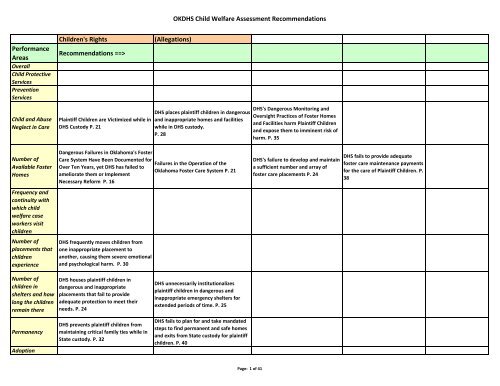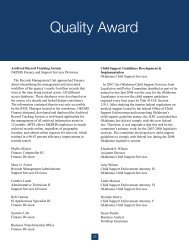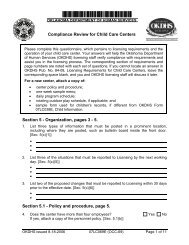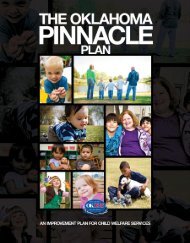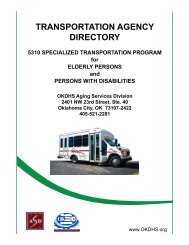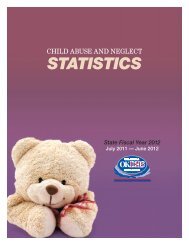Okdhs Child Welfare Assessment Recommendations - Oklahoma ...
Okdhs Child Welfare Assessment Recommendations - Oklahoma ...
Okdhs Child Welfare Assessment Recommendations - Oklahoma ...
Create successful ePaper yourself
Turn your PDF publications into a flip-book with our unique Google optimized e-Paper software.
OKDHS <strong>Child</strong> <strong>Welfare</strong> <strong>Assessment</strong> <strong>Recommendations</strong><br />
Performance<br />
Areas<br />
Overall<br />
<strong>Child</strong> Protective<br />
Services<br />
Prevention<br />
Services<br />
<strong>Child</strong>ren's Rights<br />
<strong>Recommendations</strong> ==><br />
(Allegations)<br />
<strong>Child</strong> and Abuse<br />
Neglect in Care<br />
Plaintiff <strong>Child</strong>ren are Victimized while in<br />
DHS Custody P. 21<br />
DHS places plaintiff children in dangerous<br />
and inappropriate homes and facilities<br />
while in DHS custody.<br />
P. 28<br />
DHS's Dangerous Monitoring and<br />
Oversight Practices of Foster Homes<br />
and Facilities harm Plaintiff <strong>Child</strong>ren<br />
and expose them to imminent risk of<br />
harm. P. 35<br />
Number of<br />
Available Foster<br />
Homes<br />
Frequency and<br />
continuity with<br />
which child<br />
welfare case<br />
workers visit<br />
children<br />
Number of<br />
placements that<br />
children<br />
experience<br />
Dangerous Failures in <strong>Oklahoma</strong>'s Foster<br />
Care System Have Been Documented for<br />
Failures in the Operation of the<br />
Over Ten Years, yet DHS has failed to<br />
<strong>Oklahoma</strong> Foster Care System P. 21<br />
ameliorate them or Implement<br />
Necessary Reform P. 16<br />
DHS frequently moves children from<br />
one inappropriate placement to<br />
another, causing them severe emotional<br />
and psychological harm. P. 30<br />
DHS's failure to develop and maintain<br />
a sufficient number and array of<br />
foster care placements P. 24<br />
DHS fails to provide adequate<br />
foster care maintenance payments<br />
for the care of Plaintiff <strong>Child</strong>ren. P.<br />
38<br />
Number of<br />
children in<br />
shelters and how<br />
long the children<br />
remain there<br />
DHS houses plaintiff children in<br />
dangerous and inappropriate<br />
placements that fail to provide<br />
adequate protection to meet their<br />
needs. P. 24<br />
DHS unnecessarily institutionalizes<br />
plaintiff children in dangerous and<br />
inappropriate emergency shelters for<br />
extended periods of time. P. 25<br />
Permanency<br />
Adoption<br />
DHS prevents plaintiff children from<br />
maintaining critical family ties while in<br />
State custody. P. 32<br />
DHS fails to plan for and take mandated<br />
steps to find permanent and safe homes<br />
and exits from State custody for plaintiff<br />
children. P. 40<br />
Page: 1 of 41
OKDHS <strong>Child</strong> <strong>Welfare</strong> <strong>Assessment</strong> <strong>Recommendations</strong><br />
Performance<br />
Areas<br />
<strong>Child</strong>ren's Rights<br />
<strong>Recommendations</strong> ==><br />
(Allegations)<br />
Reasonable<br />
caseloads for<br />
child welfare<br />
workers<br />
DHS's failure to adequately monitor the<br />
safety of children in DHS custody<br />
subjects plaintiff children to harm or<br />
imminent risk of harm. P. 33<br />
Excessive Caseloads, Inexperienced<br />
Caseworkers, Inadequate Supervision,<br />
High Turnover and Inadequate Training<br />
threaten basic child safety. P. 33<br />
Organizational<br />
Structure<br />
Continuous<br />
Quality<br />
Improvement<br />
processes<br />
Training/<br />
workforce<br />
development<br />
Other<br />
DHS fails to arrange mental health<br />
services for Plaintiff <strong>Child</strong>ren. P. 41<br />
Plaintiff <strong>Child</strong>ren are denied adequate<br />
and effective legal representation in the<br />
juvenile courts. P. 42<br />
Breach of the <strong>Oklahoma</strong> State Plan<br />
Contracts Harms Plaintiff <strong>Child</strong>ren. P.<br />
43<br />
Page: 2 of 41
OKDHS <strong>Child</strong> <strong>Welfare</strong> <strong>Assessment</strong> <strong>Recommendations</strong><br />
Performance<br />
Areas<br />
Overall<br />
<strong>Child</strong> Protective<br />
Services<br />
Prevention<br />
Services<br />
<strong>Child</strong> and Abuse<br />
Neglect in Care<br />
Viola Miller<br />
<strong>Recommendations</strong> ==><br />
<strong>Oklahoma</strong> should initiate a comprehensive<br />
business process analysis and redesign of the<br />
child welfare system with the ultimate<br />
“product” being the safety, permanency, and<br />
well-being of children. Restructuring without<br />
systemic culture change is no more than<br />
logistics. In contrast, a product-based business<br />
process analysis will be founded on a<br />
thoughtful outcomes-based approach to<br />
service delivery.<br />
DHS should carefully monitor and refine the<br />
implementation of its dual-track CPS system in<br />
accordance with best practice standards.<br />
DHS should develop an integrated,<br />
comprehensive system of reporting, tracking,<br />
and monitoring outcomes, in particular the<br />
abuse and neglect of all children in care.<br />
CPS should begin joint investigations with<br />
the Office of Client Advocacy for all abuse<br />
and neglect reports involving custody<br />
children in congregate care. The findings<br />
of these investigations should be included<br />
in KIDS and reported to the federal<br />
government.<br />
Number of<br />
Available Foster<br />
Homes<br />
DHS should develop and implement a dual<br />
certification program for foster and adoptive<br />
families to support a network of family-based<br />
placement services that are most likely to<br />
result in permanency, and to minimize<br />
placement instability.<br />
DHS should implement a continuous<br />
state, county, and community-based<br />
resource home needs assessment,<br />
including generic, targeted, and childspecific<br />
goals and strategies.<br />
DHS should develop,<br />
implement and monitor a plan<br />
for recruitment and retention<br />
of resource homes based on<br />
goals established from the<br />
needs assessment and should<br />
engage current resource<br />
families in this work.<br />
Frequency and<br />
continuity with<br />
which child<br />
welfare case<br />
workers visit<br />
children<br />
Number of<br />
placements that<br />
children<br />
experience<br />
DHS should develop and implement a dual<br />
certification program for foster and adoptive<br />
families to support a network of family-based<br />
placement services that are most likely to<br />
result in permanency, and to minimize<br />
placement instability.<br />
Page: 3 of 41
OKDHS <strong>Child</strong> <strong>Welfare</strong> <strong>Assessment</strong> <strong>Recommendations</strong><br />
Performance<br />
Areas<br />
Number of<br />
children in<br />
shelters and how<br />
long the children<br />
remain there<br />
Permanency<br />
Adoption<br />
Reasonable<br />
caseloads for<br />
child welfare<br />
workers<br />
Viola Miller<br />
<strong>Recommendations</strong> ==><br />
DHS should immediately develop and<br />
implement a plan to eliminate the use of<br />
emergency placements (particularly shelters),<br />
and reallocate those resources to develop an<br />
adequately funded, supported, and monitored<br />
placement system.<br />
DHS should abandon its antiquated workload<br />
analysis and develop a sustainable approach to<br />
workload management. This approach must<br />
not only include adherence to acceptable<br />
caseload standards, but it must also establish a<br />
mechanism for ensuring equity in assignment.<br />
Use of aggregate data and averages to<br />
determine caseload compliance must cease.<br />
Caseloads can only be managed at the<br />
individual staff level.<br />
DHS should initiate a “right sizing”<br />
initiative and seize the opportunity to<br />
reallocate staffing to child welfare as<br />
necessary.<br />
DHS should ensure the<br />
presence of a sufficient<br />
number of caseworkers and<br />
supervisors at all times by<br />
developing strategies to<br />
mitigate vacancies and<br />
turnover.<br />
Organizational<br />
Structure<br />
DHS should develop a dynamic leadership team<br />
to drive the child welfare change initiative over<br />
the coming years. The systemic reform needed<br />
will require strong leadership with a clear<br />
vision of work that is child-centered, familyfocused,<br />
strengths-based, and culturally<br />
responsive.<br />
DHS should develop well-defined<br />
responsibilities and accountability for<br />
every position in the child welfare<br />
system, and set clear goals and<br />
objections for its child welfare staff.<br />
Continuous<br />
Quality<br />
Improvement<br />
processes<br />
DHS should implement a child welfare<br />
Performance Quality Assurance (PQA) office<br />
answering directly to top child welfare<br />
leadership. This office must have as much<br />
independence from bureaucratic interference<br />
as possible. The PQA should include the use of<br />
a standardized quality services review process<br />
for measuring the casework and outcomes of<br />
individual custody children. This office should<br />
also provide leadership for the implementation<br />
of a continuous quality improvement process<br />
that involves all staff across the agency as well<br />
as stakeholders outside the agency, including<br />
providers, community partners, service<br />
recipients, and foster parents.<br />
DHS should implement a Quality Services<br />
Review (QSR) for evaluating cases of<br />
children in custody, which should include<br />
external reviewers along with DHS staff.<br />
DHS should implement a<br />
process to ensure that QSR<br />
recommendations are<br />
followed and action steps<br />
implemented.<br />
PQA should become the<br />
repository for all contracts<br />
and provider monitoring<br />
information. It should<br />
regularly review all<br />
information available on each<br />
provider to determine the<br />
safety and well-being of<br />
children, and should make<br />
recommendations in writing<br />
regarding the continuation of<br />
contracting based on the<br />
information reviewed.<br />
Page: 4 of 41
OKDHS <strong>Child</strong> <strong>Welfare</strong> <strong>Assessment</strong> <strong>Recommendations</strong><br />
Performance<br />
Areas<br />
Viola Miller<br />
<strong>Recommendations</strong> ==><br />
Training /<br />
workforce<br />
development<br />
DHS should develop an enhanced professional<br />
development program that is integrated and<br />
monitored; based on accepted principles of<br />
adult learning, including coaching and<br />
mentoring; and focused on outcomes for<br />
children and families.<br />
DHS should develop a more integrated<br />
approach to professional development in<br />
cooperation with the state’s university<br />
system.<br />
DHS should develop specific<br />
curricula for both pre-service<br />
and in-service training for the<br />
child welfare workforce.<br />
DHS should continue to<br />
enhance its child welfare<br />
supervision training<br />
curriculum, including a<br />
performance competency<br />
evaluation.<br />
New worker training<br />
should require<br />
successful completion<br />
of a performance<br />
competency evaluation<br />
prior to caseload<br />
assignment.<br />
DHS should ensure that<br />
private provider<br />
caseworkers meet the<br />
same professional<br />
development standards<br />
as the public system<br />
staff.<br />
Other<br />
DHS should implement a high-quality data<br />
management system. This system must be<br />
staffed with the expertise necessary to ensure<br />
data integrity, and must allow the use of data<br />
reporting and analysis to inform decisionmaking<br />
and evaluate agency effectiveness on<br />
measurable outcomes.<br />
DHS should establish and monitor<br />
performance outcome measures for both<br />
public and private service providers and<br />
hold both accountable for those<br />
outcomes.<br />
DHS should implement<br />
performance based<br />
contracting.<br />
DHS should ensure that all<br />
private agency monitoring and<br />
licensure information is<br />
integrated and used to inform<br />
contract decision-making.<br />
Page: 5 of 41
OKDHS <strong>Child</strong> <strong>Welfare</strong> <strong>Assessment</strong> <strong>Recommendations</strong><br />
Performance<br />
Areas<br />
Overall<br />
Hornby-Zeller<br />
<strong>Recommendations</strong> ==><br />
<strong>Child</strong> protective<br />
Services<br />
The Legislature should review the<br />
proposed Title 10 revisions to ensure<br />
that the sole criterion for removal of<br />
a child from his or her home is an<br />
imminent safety threat.<br />
The Legislature should modify Title 10 so that<br />
DHS is involved with the police in all<br />
removals of children from their homes and<br />
so that the authority for “standing orders” is<br />
eliminated<br />
DHS should contract with<br />
District Attorneys (DAs) to<br />
represent DHS in deprivation<br />
proceedings<br />
DHS should establish one<br />
centralized hotline number for<br />
all reports of the abuse and<br />
neglect of children within the<br />
<strong>Child</strong> and Family Services<br />
Division and strongly consider<br />
whether vulnerable adults can<br />
be included as well.<br />
DHS should simplify and clarify the<br />
definitions of Priorities One and<br />
Two and the criteria for<br />
investigations versus assessments;<br />
modify response times; and modify<br />
the daily contact rule.<br />
Prevention<br />
Services<br />
DHS should increase the use of courtsupervised<br />
in-home placements for<br />
children who otherwise would have<br />
been removed but the safety issues<br />
have been resolved.<br />
DHS should shift funding from out-of-home<br />
care to in-home services to support the<br />
families where children are not in imminent<br />
danger. DHS should increase the numbers<br />
and kinds of in-home services available<br />
based on an Area-level needs assessment<br />
(see Recommendation 18) and the use of<br />
evidence-based practices.<br />
<strong>Child</strong> abuse and<br />
neglect in care<br />
DHS should streamline its licensing<br />
processes. At a minimum it should develop a<br />
single process for resource families or Bridge<br />
homes which includes all foster and adoptive<br />
families. At a more ambitious level, it should<br />
look at consolidating the requirements if not<br />
the staff for all home-based licensing within<br />
the agency, across the divisions of child care,<br />
developmental disabilities and child and<br />
family services. In addition, families who are<br />
licensed to provide one service such as child<br />
care should not be excluded from providing<br />
another such as foster care, although limits<br />
should be maintained on the number of<br />
children a family can care for at a time<br />
Page: 6 of 41
OKDHS <strong>Child</strong> <strong>Welfare</strong> <strong>Assessment</strong> <strong>Recommendations</strong><br />
Performance<br />
Areas<br />
Number of<br />
available foster<br />
homes<br />
Hornby-Zeller<br />
<strong>Recommendations</strong> ==><br />
The legislature should provide foster families<br />
with an increase both in the daily rate and in<br />
DHS Area Directors should work with their ability to be reimbursed for clothing<br />
their recruitment staff to develop a when a child newly comes to the home, even<br />
resource recruitment plan based on if the initial $150 has already been spent<br />
the number of children in non-relative elsewhere on the same child in another<br />
care and the projected foster family placement. Additionally, there should be<br />
turnover, which meets the standard some provisions for transportation<br />
of two available beds per child. reimbursement based on the requirements<br />
of the service plan, unless the family is<br />
receiving a difficulty of care payment.<br />
Frequency and<br />
continuity with<br />
which child<br />
welfare case<br />
workers visit<br />
children<br />
Number of<br />
placements that<br />
children<br />
experience<br />
Number of<br />
children in<br />
shelters and how<br />
long the children<br />
remain there<br />
Permanency<br />
Caseworkers should be required to<br />
visit with children privately at least<br />
every few months, and preferably at<br />
every visit. (<br />
DHS should phase out the two large<br />
publicly funded shelters, Laura Dester<br />
and Pauline E. Mayer, and replace<br />
them with emergency foster homes<br />
when alternative placements such as<br />
neighbors and relatives cannot be<br />
found.<br />
The Commission on <strong>Child</strong>ren and Youth<br />
should assume responsibility for licensing all<br />
congregate out-of-home care facilities<br />
operated directly by DHS.<br />
Adoption<br />
DHS should move the SWIFT Adoption<br />
workers to the Field Operations<br />
Division and integrate them into the<br />
agency’s local offices.<br />
Page: 7 of 41
OKDHS <strong>Child</strong> <strong>Welfare</strong> <strong>Assessment</strong> <strong>Recommendations</strong><br />
Performance<br />
Areas<br />
Reasonable<br />
caseloads for<br />
child welfare<br />
workers<br />
Hornby-Zeller<br />
<strong>Recommendations</strong> ==><br />
The Legislature and the Governor<br />
should provide a consistent means of<br />
funding salary increases for DHS staff<br />
based on performance.<br />
DHS should experiment with recruiting staff<br />
with different demographic characteristics to<br />
determine which groups are more likely to<br />
stay with the agency longer periods of time.<br />
Organizational<br />
Structure<br />
Area offices should assume direct<br />
responsibility for functions which<br />
cross county lines.<br />
Within <strong>Oklahoma</strong> and Tulsa Counties only,<br />
DHS should replace the positions of County<br />
Director and field liaison with programmatic<br />
directors for each of the programs within the<br />
Human Services Centers<br />
The central office program<br />
divisions should conduct a<br />
periodic statewide services<br />
needs assessment and<br />
allocate funding to each Area<br />
office for contracted services,<br />
and the Area offices should<br />
assume responsibility for<br />
deciding which contracts to<br />
fund within their boundaries.<br />
DHS administrators should act<br />
with greater speed to correct<br />
personnel performance<br />
problems, especially among<br />
Area and County Directors<br />
whose positions are<br />
unclassified.<br />
Continuous<br />
Quality<br />
Improvement<br />
processes<br />
The Continuous Quality Improvement<br />
unit within CFSD should review its<br />
instrument and procedures to ensure<br />
a focus on the quality of casework,<br />
including the soundness of<br />
assessments and decision-making,<br />
and DHS should develop a clear<br />
structure of accountability based on<br />
the results of those reviews, including<br />
both positive and negative sanctions.<br />
Training/<br />
workforce<br />
development<br />
Other<br />
DHS should revise its training<br />
materials to create a formal<br />
curriculum which provides<br />
information in a logical order and<br />
helps workers gain the competencies<br />
they need to perform their jobs at a<br />
high level.<br />
DHS should develop a Passport<br />
Program for foster children similar to<br />
those developed in Texas and<br />
Washington.<br />
DHS should ensure that every worker<br />
receives job-specific training as soon after<br />
starting a position as possible.<br />
Page: 8 of 41
OKDHS <strong>Child</strong> <strong>Welfare</strong> <strong>Assessment</strong> <strong>Recommendations</strong><br />
Performance<br />
Areas<br />
Overall<br />
<strong>Child</strong> Protective<br />
Services<br />
Prevention<br />
Services<br />
<strong>Child</strong> and Abuse<br />
Neglect in Care<br />
Number of<br />
Available Foster<br />
Homes<br />
Frequency and<br />
continuity with<br />
which child<br />
welfare case<br />
workers visit<br />
children<br />
Number of<br />
placements that<br />
children<br />
experience<br />
Robin Arnold Williams<br />
<strong>Recommendations</strong> ==><br />
Continue progress meeting federal<br />
expectations in the area of monthly<br />
visitation between case workers and<br />
children.<br />
Continue to develop and implement a<br />
broader array and depth of necessary<br />
services to address needs of children<br />
and families who come into contact<br />
with the child welfare system as well<br />
as support foster and kinship<br />
providers. Specific priority should be<br />
placed on expanded quality<br />
placement options and supports to<br />
provide safety of children in out of<br />
home care, continue to reduce<br />
utilization of shelter care, and<br />
improve placement stability.<br />
Page: 9 of 41
OKDHS <strong>Child</strong> <strong>Welfare</strong> <strong>Assessment</strong> <strong>Recommendations</strong><br />
Performance<br />
Areas<br />
Robin Arnold Williams<br />
<strong>Recommendations</strong> ==><br />
Number of<br />
children in<br />
shelters and how<br />
long the children<br />
remain there<br />
Permanency<br />
Adoption<br />
Reasonable<br />
caseloads for<br />
child welfare<br />
workers<br />
Organizational<br />
Structure<br />
Increase the number of staff and<br />
continue to improve the experience<br />
level and practice competencies of<br />
staff responsible for day to day work<br />
on child welfare cases.<br />
Improve the tracking, reporting and<br />
management of child welfare caseload<br />
and workload to assure effective<br />
allocation and utilization of available<br />
staff resources.<br />
Continuous<br />
Quality<br />
Improvement<br />
processes<br />
Continue to execute the established<br />
Continuous Quality Improvement<br />
(CQI) case review process to provide<br />
both quantitative and qualitative<br />
performance data and take steps to<br />
improve the CQI case review process<br />
with respect to involvement of<br />
outside individuals and entities,<br />
transparency of results, and more<br />
formalized feedback and follow up<br />
processes.<br />
Page: 10 of 41
OKDHS <strong>Child</strong> <strong>Welfare</strong> <strong>Assessment</strong> <strong>Recommendations</strong><br />
Performance<br />
Areas<br />
Training/<br />
workforce<br />
development<br />
Other<br />
Robin Arnold Williams<br />
<strong>Recommendations</strong> ==><br />
Fully integrate the <strong>Child</strong> <strong>Welfare</strong><br />
Practice Model into all training, policy,<br />
practice and performance<br />
expectations of child welfare staff at<br />
all levels and of management staff<br />
who supervise or provide support<br />
services to them.<br />
Page: 11 of 41
OKDHS <strong>Child</strong> <strong>Welfare</strong> <strong>Assessment</strong> <strong>Recommendations</strong><br />
Performance<br />
Areas<br />
Overall<br />
<strong>Child</strong> Protective<br />
Services<br />
Kathryn Simms<br />
<strong>Recommendations</strong> ==><br />
("Findings" in this case)<br />
The findings of the assessment review<br />
indicate that the appropriate response to<br />
address allegations of safety threats was<br />
not consistently taken by OKDHS staff.<br />
The review sample was very small so the<br />
issues concerning safety threats and<br />
response timeframes were noted in only<br />
four cases, and in none of those cases<br />
were injuries to the child victim alleged<br />
or found to have been present during the<br />
assessment.<br />
Prevention<br />
Services<br />
<strong>Child</strong> and Abuse<br />
Neglect in Care<br />
Number of<br />
Available Foster<br />
Homes<br />
Frequency and<br />
continuity with<br />
which child<br />
welfare case<br />
workers visit<br />
children<br />
The types of abuse/neglect that were<br />
most frequently substantiated in the Part<br />
II review sample were threat of harm<br />
and failure to protect. In 80% of the Part<br />
II investigations, the action taken in<br />
response to the findings of the<br />
investigation was to make a placement<br />
change for the child. Further action, such<br />
as referral back to the child's<br />
permanency worker or the Resource<br />
Family Specialist for services or a written<br />
plan of compliance was recommended in<br />
only 7 of the investigations. Only 10<br />
homes had children who remained in the<br />
home following the substantiated<br />
investigation.<br />
There were concerns noted in the case<br />
reviews specifically:<br />
foster parents in the sample;<br />
assessments;<br />
assessments or investigations; and<br />
not accurately identified.<br />
These concerns, however, did not<br />
represent a system wide failure to protect<br />
children's safety. While<br />
there were some errors in decision‐making<br />
and there was not timely response in every<br />
case, this was clearly not a pattern or<br />
evidence of disregard for the safety of<br />
children.<br />
The review findings did indicate a concern<br />
with the assignment of the reports as<br />
assessments, only four reports were<br />
correctly assigned as assessments. As<br />
expected, the most frequent issues in the<br />
reports of abuse or neglect that were<br />
assigned as assessments were lack of<br />
supervision and threat of harm. There<br />
were, however, also allegations that<br />
involved injuries and actions of the foster<br />
parents that posed safety threats to<br />
children under the age of three. Based on<br />
the OKDHS policy concerning ssessments,<br />
13 reports should have been assigned for<br />
investigation rather than assessment.<br />
The majority of children who<br />
remained in the foster home<br />
following the substantiated<br />
investigation had previously<br />
received good care in the foster<br />
home and the allegations were<br />
such that the children could<br />
remain safely in the home if<br />
follow‐up services were provided<br />
to the foster parents.<br />
Page: 12 of 41
OKDHS <strong>Child</strong> <strong>Welfare</strong> <strong>Assessment</strong> <strong>Recommendations</strong><br />
Performance<br />
Areas<br />
Number of<br />
placements that<br />
children<br />
experience<br />
Number of<br />
children in<br />
shelters and how<br />
long the children<br />
remain there<br />
Permanency<br />
Adoption<br />
Reasonable<br />
caseloads for<br />
child welfare<br />
workers<br />
Organizational<br />
Structure<br />
Continuous<br />
Quality<br />
Improvement<br />
processes<br />
Training/<br />
workforce<br />
development<br />
Other<br />
Kathryn Simms<br />
<strong>Recommendations</strong> ==><br />
("Findings" in this case)<br />
Page: 13 of 41
OKDHS <strong>Child</strong> <strong>Welfare</strong> <strong>Assessment</strong> <strong>Recommendations</strong><br />
Performance<br />
Areas<br />
OVERALL<br />
Chadwick Trauma<br />
<strong>Recommendations</strong> ==><br />
Integrate a Screening Tool Designed to Assess a <strong>Child</strong>’s<br />
Trauma History into <strong>Child</strong> <strong>Welfare</strong> Practice: This may<br />
be a tool focused specifically on trauma or embedding<br />
questions related to trauma into the current child<br />
welfare assessment. A screening tool or process is<br />
effective for a number of reasons: 1) It ensures that<br />
the worker has a complete understanding of the<br />
trauma that a child has experienced, which may help<br />
direct a more effective case plan. 2) It aids the worker<br />
in embedding a “trauma lens” into their work, as it<br />
helps the worker to see a child’s reactions in relation<br />
to trauma (where appropriate) and apply the training<br />
and education that they have received on trauma to a<br />
specific case, and 3) It helps the worker determine if a<br />
child needs to be referred for trauma-specific<br />
treatment.<br />
<strong>Child</strong> Protective<br />
Services<br />
Prevention<br />
Services<br />
<strong>Child</strong> and Abuse<br />
Neglect in Care<br />
Number of<br />
Available Foster<br />
Homes<br />
Frequency and<br />
continuity with<br />
which child<br />
welfare case<br />
workers visit<br />
children<br />
Structured <strong>Assessment</strong> for Birth Parents: While the<br />
system is aware that many parents involved with the<br />
child welfare system have had their own trauma<br />
histories, it does not appear that there is any sort of<br />
structured assessment or referral process for birth<br />
parents. In recent years, it has become increasingly<br />
clear that helping birth parents address and work<br />
through their own trauma plays a critical role in<br />
helping families involved with the child welfare<br />
system.<br />
Address Psychological Safety: Continue to address<br />
psychological safety in very active and concrete<br />
ways throughout a child and family’s involvement<br />
with the child welfare system.<br />
Page: 14 of 41
OKDHS <strong>Child</strong> <strong>Welfare</strong> <strong>Assessment</strong> <strong>Recommendations</strong><br />
Performance<br />
Areas<br />
Number of<br />
placements that<br />
children<br />
experience<br />
Chadwick Trauma<br />
<strong>Recommendations</strong> ==><br />
Trauma Training for Resource Parents: Although child<br />
welfare workers and supervisors identified resource<br />
parent training as a strength, the youth and resource<br />
parents themselves expressed a need for more<br />
training specific to trauma for substitute caregivers.<br />
Implementation of Caring for <strong>Child</strong>ren who have<br />
Experienced Trauma: A Workshop for Resource<br />
Parents (NCTSN) would improve the resource parent’s<br />
ability to manage trauma reactions and therefore<br />
increase stability and well-being for children in care.<br />
The Foster Parent Newsletter Regarding Trauma-<br />
Informed CW Practice could be used to educate<br />
resource parents statewide.<br />
Number of<br />
children in<br />
shelters and how<br />
long the children<br />
remain there<br />
Permanency<br />
Increase Training for Birth Parents: While the results<br />
of the current assessment suggest that staff members<br />
actively engage with birth parents and recognize that<br />
many of them have experienced their own trauma,<br />
the results also suggest that there is no mechanism in<br />
place to provide training and education to birth<br />
parents on understanding trauma and working with<br />
their children regarding trauma behaviors and<br />
reactions. It is recommended that training for birth<br />
parents on trauma become embedded in the service<br />
plan to increase the likelihood of successful and<br />
permanent reunification.<br />
Adoption<br />
Page: 15 of 41
OKDHS <strong>Child</strong> <strong>Welfare</strong> <strong>Assessment</strong> <strong>Recommendations</strong><br />
Performance<br />
Areas<br />
Chadwick Trauma<br />
<strong>Recommendations</strong> ==><br />
Reasonable<br />
caseloads for<br />
child welfare<br />
workers<br />
Provide Increased Staff Support to Decrease Staff<br />
Turnover, Secondary Trauma, and Increase Stability<br />
and Support for Families: One of the great challenges<br />
to becoming a trauma-informed child welfare system<br />
is providing support to the child welfare workforce.<br />
Due to the increasing demands of time, high<br />
caseloads, and decreased funding, coupled with the<br />
emotional toll it takes to work with traumatized<br />
children and families on a daily basis, turnover rates<br />
for workers are high. Traditionally, training designed<br />
to address secondary trauma has focused primarily on<br />
providing workers with strategies on how to take care<br />
of themselves once they leave the office. However,<br />
this has not proven to be enough. There is a need to<br />
integrate self-care strategies into the daily practice of<br />
workers and to address vicarious trauma on an<br />
organizational level. This includes integrating<br />
processing of challenging cases into supervision,<br />
providing training on secondary traumatic stress and<br />
related coping skills during initial training and ongoing<br />
staff training, and utilizing a curriculum designed to<br />
address secondary trauma in child welfare workers.<br />
Organizational<br />
Structure<br />
Continuous<br />
Quality<br />
Improvement<br />
processes<br />
Training/<br />
workforce<br />
development<br />
Increase Training: The theme of “increased training”<br />
emerged multiple times in both the focus groups and<br />
within responses on the TSRT. Large scale efforts<br />
related to trauma training are recommended to be<br />
initiated across the system, including child welfare<br />
staff, mental health providers, and parents. The<br />
training should cover topics such as types of trauma,<br />
impact of trauma across domains, and how to<br />
effectively manage and address trauma.<br />
Facilitate Agency Culture Change by Embedding<br />
Consultation and Education Related to Trauma<br />
into Supervision and Team Meetings: While it is<br />
critical for individuals to receive training on<br />
trauma, it is only the first step. In order to support<br />
workers’ efforts to integrate trauma knowledge<br />
and awareness into their daily practice, it is vital<br />
to embed trauma language and discussion into<br />
existing supervision and team meeting structures.<br />
Page: 16 of 41
OKDHS <strong>Child</strong> <strong>Welfare</strong> <strong>Assessment</strong> <strong>Recommendations</strong><br />
Performance<br />
Areas<br />
Chadwick Trauma<br />
<strong>Recommendations</strong> ==><br />
Other<br />
Resource Lists: Line workers and supervisors<br />
expressed a strong interest in having a list of the<br />
resources that are available in their community<br />
(particularly mental health programs that provide<br />
trauma-focused services for both adults and children)<br />
that is easy to access and use. While creating such a<br />
database may be time-consuming on the front end, it<br />
will help save time and create an infrastructure for<br />
appropriate treatment referral in the long run.<br />
Promote Regular Communication and Care<br />
Coordination with Other Service Providers: The<br />
results from the current assessment suggest that<br />
workers feel strongly that increased care<br />
coordination and communication across service<br />
systems is a key component of a trauma-informed<br />
child welfare system. They identified that, while<br />
they feel it is important to increase this<br />
communication, it is somewhat challenging to<br />
work with other systems. Therefore, there are a<br />
number of strategies that may be used to increase<br />
coordination across systems: (1) Collaborate with<br />
mental health partners to provide cross-trainings<br />
to judges, schools, etc., on the topic of trauma and<br />
its impact on children; (2) Utilize a traumainformed<br />
court report; (3) Conduct family team<br />
meetings that include all individuals who work<br />
with the child and family in the same meeting;<br />
and (4) Conduct multi-disciplinary team meetings<br />
regarding a specific child or case that includes<br />
individuals from multiple systems at the table,<br />
discussing the best ways to support the child and<br />
family.<br />
Page: 17 of 41
OKDHS <strong>Child</strong> <strong>Welfare</strong> <strong>Assessment</strong> <strong>Recommendations</strong><br />
Performance<br />
Areas<br />
Overall<br />
<strong>Child</strong> Protective<br />
Services<br />
Prevention<br />
Services<br />
<strong>Child</strong> and Abuse<br />
Neglect in Care<br />
OKDHS STRATEGIC PLAN 2011-<br />
2016<br />
<strong>Recommendations</strong> ==><br />
Standardized intake process (OKHDS<br />
Abuse and Neglect Hotline);<br />
Safe care is an evidenced based<br />
parent training curriculum for parents<br />
who are at-risk or who have been<br />
reported for child maltreatment.<br />
OKDHS child welfare staff conducts at<br />
least one monthly visit with children<br />
who are in out-of-home care. Contact<br />
guidelines focus on safety<br />
,permanency, and well being.<br />
<strong>Assessment</strong> of child safety and safety<br />
planning meeting.<br />
Family functional assessment and<br />
behaviorally based case management;<br />
Ongoing assessment<br />
Number of<br />
Available Foster<br />
Homes<br />
Frequency and<br />
continuity with<br />
which child<br />
welfare case<br />
workers visit<br />
children<br />
Number of<br />
placements that<br />
children<br />
experience<br />
Number of<br />
children in<br />
shelters and how<br />
long the children<br />
remain there<br />
Family team meetings; Bridge program Case transfer meetings<br />
Intentional visitation with child and<br />
parents;<br />
ongoing assessment<br />
OKDHS child welfare staff conducts at<br />
least one monthly visit with children who<br />
are in out-of-home care. Contact<br />
guidelines focus on safety ,permanency,<br />
and well being.<br />
Permanency<br />
Adoption<br />
OKDHS is focused on safely reunifying<br />
families. Families receive serves<br />
focused on reducing risk and safety to<br />
their children.<br />
Concurrent planning<br />
Family engagement and involvement<br />
of extended family can often lead to<br />
safer and quicker reunification for<br />
children (family team meetings).<br />
Page: 18 of 41
OKDHS <strong>Child</strong> <strong>Welfare</strong> <strong>Assessment</strong> <strong>Recommendations</strong><br />
Performance<br />
Areas<br />
Reasonable<br />
caseloads for<br />
child welfare<br />
workers<br />
Organizational<br />
Structure<br />
Continuous<br />
Quality<br />
Improvement<br />
processes<br />
Training/<br />
workforce<br />
development<br />
Other<br />
OKDHS STRATEGIC PLAN 2011-<br />
2016<br />
<strong>Recommendations</strong> ==><br />
Develop a statewide system for<br />
trauma informed child welfare<br />
system.<br />
National Youth in Transition Database<br />
<strong>Oklahoma</strong> Bridge to Independence<br />
Network to help youth in transition.<br />
Page: 19 of 41
OKDHS <strong>Child</strong> <strong>Welfare</strong> <strong>Assessment</strong> <strong>Recommendations</strong><br />
Performance<br />
Areas<br />
Overall<br />
<strong>Child</strong> Protective<br />
Services<br />
Prevention<br />
Services<br />
<strong>Child</strong> and Abuse<br />
Neglect in Care<br />
Number of<br />
Available Foster<br />
Homes<br />
Frequency and<br />
continuity with<br />
which child<br />
welfare case<br />
workers visit<br />
children<br />
Number of<br />
placements that<br />
children<br />
experience<br />
Number of<br />
children in<br />
shelters and how<br />
long the children<br />
remain there<br />
Program Improvement Plan<br />
<strong>Recommendations</strong> ==><br />
Revising policies and procedures related<br />
Revising policies and practices for<br />
to prioritizing allegations of<br />
screening allegations of maltreatment.<br />
maltreatment and investigating<br />
P. 12<br />
complaints. P. 12<br />
Developing and implementing county<br />
specific plans to increase resource<br />
availability. P. 12<br />
Permanency<br />
Simplifying the individual service plan<br />
and implementing protocols to<br />
increase family involvement in all<br />
aspects of service delivery. P. 12<br />
Implementing protocols to increase<br />
family (especially absent fathers) and<br />
tribal involvement in all aspects of<br />
service delivery. P. 12<br />
Page: 20 of 41
OKDHS <strong>Child</strong> <strong>Welfare</strong> <strong>Assessment</strong> <strong>Recommendations</strong><br />
Performance<br />
Areas<br />
Adoption<br />
Reasonable<br />
caseloads for<br />
child welfare<br />
workers<br />
Organizational<br />
Structure<br />
Continuous<br />
Quality<br />
Improvement<br />
processes<br />
Training/<br />
workforce<br />
development<br />
Other<br />
Program Improvement Plan<br />
<strong>Recommendations</strong> ==><br />
Developing and implementing a<br />
supervisory case review protocol<br />
incorporating CFSR values and<br />
expectations. P. 12<br />
Developing and implementing a peer<br />
case review which integrates the<br />
expectations of the supervisory review.<br />
P. 12<br />
Page: 21 of 41
OKDHS <strong>Child</strong> <strong>Welfare</strong> <strong>Assessment</strong> <strong>Recommendations</strong><br />
C<br />
Performance<br />
Areas<br />
<strong>Oklahoma</strong> CFSR<br />
<strong>Recommendations</strong> ==><br />
Overall<br />
<strong>Child</strong> Protective<br />
Services<br />
Prevention<br />
Services<br />
<strong>Child</strong> and Abuse<br />
Neglect in Care<br />
OKDHS plans to build on the group established to<br />
develop the <strong>Oklahoma</strong> Statewide <strong>Assessment</strong> prior to<br />
the Federal CFSR. The group’s activities continued with<br />
the development of the Program Improvement Plan.<br />
While this group was not involved directly in the writing<br />
of the CFSP, information gathered by and from this<br />
group was used to develop strategies for the plan.<br />
OKDHS plans to enhance this process by creating a <strong>Child</strong><br />
<strong>Welfare</strong> Steering Committee. Membership on this<br />
committee will include community stakeholders and<br />
OKDHS staff who have been involved in the statewide<br />
assessment and program improvement plan, as well as<br />
any additional interested parties to be identified in the<br />
future. OKDHS will invite more participation from tribes<br />
that will engage agency personnel, including individuals<br />
that have a stake in the child welfare system. P. 45<br />
Centralized Hotline:<br />
Implementation of the Centralized Hotline continues.<br />
The majority of the state is now being served by the<br />
centralized hotline. The remaining counties in northeast<br />
<strong>Oklahoma</strong> will be online soon. A second location at the<br />
Rogers County office, Claremore, <strong>Oklahoma</strong> has been<br />
secured to house the remaining members of the<br />
centralized hotline. This location will allow the<br />
remaining counties to be served. This second location<br />
will also provide a back up for the <strong>Oklahoma</strong> City facility<br />
should the need arise. P. 18<br />
Technical assistance will be sought to assist the state in<br />
developing and convening an independent group that<br />
can and will make recommendations for the<br />
improvement of the State of <strong>Oklahoma</strong>’s child welfare<br />
system. OKDHS will ask for technical assistance to<br />
focus on responsiveness at the local level. Most<br />
counties currently have some form of team developed<br />
but may be focused on individual cases. Counties need<br />
to be encouraged to develop teams that will have an<br />
impact in the community and make recommendation<br />
to OKDHS regarding services and to the court system<br />
regarding safety, permanency, and well-being. P. 45<br />
As a result of the PIP, a strategy has been developed to<br />
increase the capacity of the county directors who are<br />
involved in their local community partnership boards.<br />
P. 46<br />
<strong>Assessment</strong> of <strong>Child</strong> Safety:<br />
The CFSD, Permanency Planning staff are currently in<br />
the process of developing a workgroup of both CFSD<br />
and FOD staff to look at making adjustments to the<br />
AOCS for use in the on-going assessment of children<br />
and families. All of the Permanency Planning Core:<br />
Level 1 and 2 training sessions have been updated to<br />
offer case scenarios for staff to practice critical thinking<br />
skills in using the AOCS.P. 18<br />
Counties will encourage involvement by the tribes<br />
in planning, training, and other child welfare<br />
endeavors. Technical assistance from Program Staff,<br />
Office of Field Operations Division and Division of<br />
<strong>Child</strong>ren and Family Services will be available to<br />
train and facilitate meetings between tribes and<br />
local OKDHS offices. P. 46<br />
KIDS plans to have the Family Functional<br />
<strong>Assessment</strong> included in the September, 2011 KIDS<br />
release The workgroup that is reviewing the AOCS<br />
will also be looking at the FFA to determine if the<br />
tools can be merged into one for the purpose of<br />
ongoing assessments of safety and functioning of<br />
children and families. All of the Permanency<br />
Planning CORE level 1 and 2 trainings have been<br />
updated to allow staff opportunities to use critical<br />
thinking skills in assessing family functioning with<br />
practice case scenarios. P. 31<br />
Counties will be encouraged to<br />
include former and present<br />
children and families that have<br />
experienced the OKDHS child<br />
welfare system. This process has<br />
occurred in several counties but<br />
needs to be expanded. Youth<br />
panels have been found to be<br />
effective at the state and county<br />
levels. P. 46<br />
Page: 22 of 41
OKDHS <strong>Child</strong> <strong>Welfare</strong> <strong>Assessment</strong> <strong>Recommendations</strong><br />
C<br />
Performance<br />
Areas<br />
<strong>Oklahoma</strong> CFSR<br />
<strong>Recommendations</strong> ==><br />
Number of<br />
Available Foster<br />
Homes<br />
Bridge:<br />
By definition, it is clear that the Bridge Model recruits, Bridge Recruitment:<br />
orients and supports traditional foster families, kin, and<br />
adoptive families. There is no distinction in approach.<br />
<strong>Oklahoma</strong> has implemented an assessment process that<br />
allows a family to be approved to provide care for<br />
children whether it is traditional foster care, kinship<br />
care or adoption. This integrated assessment includes<br />
both an initial and re-assessment tool to be utilized with<br />
all resource families to impact placement stability and<br />
time to permanency. OKDHS added a component<br />
addressing the protective capacity of resource families<br />
to the assessment guide. OKDHS will continue to<br />
evaluate the need for developing additional tools. It is<br />
anticipated that implementation of this process will<br />
reduce maltreatment in out of home care. P. 20<br />
OKDHS is in the process of developing an <strong>Oklahoma</strong><br />
specific recruitment and retention tool kit to be used<br />
in consultation with counties on developing localized<br />
recruitment plans with their community partners,<br />
while continuing to develop a consistent statewide<br />
plan with technical assistance from AdoptUSKids.<br />
Finally, the evaluation team continues to develop<br />
survey instruments to collect data on these initiatives<br />
as well as mine data from our KIDS database in order<br />
to track challenges as well as successes and continue to<br />
make adaptations to our efforts as needed. P. 20<br />
Bridge Support:<br />
Mentoring and Support Groups – The Bridge<br />
Leadership team is planning on utilizing training<br />
clusters and the Office of Faith-Based and<br />
Community Initiatives to work on forming organic<br />
support groups of parents who experience preservice<br />
training together. P. 29<br />
Effectiveness:<br />
Survey instruments are also<br />
currently under development to<br />
evaluate the effectiveness of the<br />
Bridge Family Portal website. The<br />
website currently provides: an<br />
overview of what Bridge Families<br />
do, the Bridge Family Orientation<br />
training, FAQs for the Bridge<br />
philosophy, family support<br />
resources, useful forms, Bridge<br />
Family stories, Bridge best<br />
practices and principles, and<br />
videos / resources on foster care<br />
and adoption. P. 29<br />
Effectiveness:<br />
We plan to use our<br />
SACWIS data to test the<br />
relationships between<br />
having contact with the<br />
Resource Support (Call)<br />
Center and the likelihood<br />
of being an approved<br />
home for all the different<br />
family types needed<br />
versus those families that<br />
are assisted in other ways<br />
(coming into a county<br />
office, internet, events,<br />
etc.). P. 29<br />
Frequency and<br />
continuity with<br />
which child<br />
welfare case<br />
workers visit<br />
children<br />
Number of<br />
placements that<br />
children<br />
experience<br />
OKDHS plans to utilize an enhanced visitation model in<br />
ten select counties. These sites will conduct a selfassessment,<br />
identifying areas of strength and those<br />
needing improvement, to be addressed as part of the<br />
county program improvement plan. Training will be<br />
provided to these CW staff regarding the visitation<br />
protocol. The outcomes of this plan will be utilized to<br />
identify the resources necessary for statewide<br />
implementation. P. 30<br />
OKDHS plans to utilize an enhanced visitation model in<br />
ten select counties. These sites will conduct a selfassessment,<br />
identifying areas of strength and those<br />
needing improvement, to be addressed as part of the<br />
county program improvement plan. Training will be<br />
provided to these CW staff regarding the visitation<br />
protocol. The outcomes of this plan will be utilized to<br />
identify the resources necessary for statewide<br />
implementation. P. 30<br />
Page: 23 of 41
OKDHS <strong>Child</strong> <strong>Welfare</strong> <strong>Assessment</strong> <strong>Recommendations</strong><br />
C<br />
Performance<br />
Areas<br />
<strong>Oklahoma</strong> CFSR<br />
<strong>Recommendations</strong> ==><br />
Number of<br />
children in<br />
shelters and how<br />
long the children<br />
remain there<br />
The State of <strong>Oklahoma</strong> is addressing the emergency<br />
shelter issue on both a short and long-term basis. Both<br />
<strong>Oklahoma</strong> County and Tulsa County emergency shelters<br />
have enhanced and continue to enhance their service<br />
capacity for children. Medical and psychological<br />
assessments are conducted for each child and a<br />
developmental assessment is conducted on younger<br />
children. <strong>Oklahoma</strong> County shelter continues to<br />
transport children to their community schools to<br />
alleviate disruptions in their education. P. 44<br />
As the rate of out of wedlock birth continues to grow,<br />
as do the removal rates for children under age one and<br />
the prevalence of drug affected-infants, reducing the<br />
use of emergency shelters will also require the<br />
development of special services primarily for infants.<br />
The vision includes development of implementation<br />
projects, which create standing capacity for emergency<br />
foster care homes that should virtually eliminate the<br />
need for shelter care for children under age five.<br />
OKDHS has had preliminary discussions with some<br />
providers who have expressed an interest in providing<br />
this service. The financial analysis has been<br />
preliminarily determined to be feasible for the<br />
projects. P. 44<br />
Concurrent Planning:<br />
Permanency<br />
Family Team Meetings:<br />
The FTM forms have been enhanced to include a closer<br />
look at sibling placement and at efforts to place siblings<br />
together if they have been separated. A focus has been<br />
placed on the need for every child to have frequent<br />
Family Team Meetings to improve family participation<br />
in decision making. This is being supported through<br />
CFSD Permanency Planning staff contacting <strong>Child</strong><br />
<strong>Welfare</strong> field staff when a report indicates the<br />
child/family has not had an FTM and offering to assist<br />
with planning, coordinating and facilitating an FTM. P.<br />
19<br />
OKDHS plans to revise and clarify the concurrent<br />
planning process and anticipates this will positively<br />
affect establishing permanency goals in a timely<br />
manner, attaining permanency goals timely, achieving<br />
adoptions timely, and ensuring long-term placement.<br />
On-going work with concurrent planning practices is<br />
provided through the use of Family Team Meetings<br />
and Permanency Roundtables. Both of these activities<br />
are focused on helping children achieve timely<br />
permanency, which includes a review of the Poor<br />
Prognosis Indicators. This information has been<br />
enhanced in the Permanency Planning CORE Level 1<br />
and 2 training sessions to reinforce the need for early<br />
and periodic assessment for timely permanency.<br />
<strong>Oklahoma</strong> has three types of funded guardianships.<br />
The first is supported permanency using TANF funds,<br />
the second is Title IV-E funded guardianship and the<br />
third is a state funded program for those rare cases<br />
that guardianship is in the best interest of the<br />
child(ren), but the inability to meet the requirements<br />
of the other two programs, hinders the family’s ability<br />
to obtain guardianship. P. 32<br />
Broaden Service Array/Resource Development:<br />
OKDHS plans to approach the lack of services<br />
through implementing Resource and Capacity<br />
Development Plans within the individual counties of<br />
the state. Technical assistance will be accessed to<br />
gain information on how service array has been<br />
successfully improved in other areas of the nation.<br />
This will lay the foundation for providing individual<br />
counties with training and support in developing<br />
plans to increase services at the local level. P. 42<br />
Adoption<br />
Reasonable<br />
caseloads for<br />
child welfare<br />
workers<br />
Page: 24 of 41
OKDHS <strong>Child</strong> <strong>Welfare</strong> <strong>Assessment</strong> <strong>Recommendations</strong><br />
C<br />
Performance<br />
Areas<br />
Organizational<br />
Structure<br />
<strong>Oklahoma</strong> CFSR<br />
<strong>Recommendations</strong> ==><br />
Continuous<br />
Quality<br />
Improvement<br />
processes<br />
Training/<br />
workforce<br />
development<br />
Practice Model Guidebook:<br />
Part of the OKDHS PIP is to provide an updated version<br />
of the Practice Model Guidebook. A workgroup of CFSD<br />
staff and FOD staff have met two times to discuss<br />
guidebook updates. These updates include changes to<br />
policy, new forms and reports, as well as new updates<br />
to KIDS. The OKDHS practice standards and practice<br />
model were reviewed by a tribal workgroup. This tribal<br />
workgroup provided feedback and input to enhance<br />
cultural awareness. These suggestions were submitted<br />
to the Practice Model Steering Committee. P. 18<br />
Court Improvement Project:<br />
Other<br />
Collaborative Partnerships w/ Stakeholder<br />
Participation:<br />
The development of a statewide <strong>Child</strong> <strong>Welfare</strong><br />
Stakeholder collaborative was identified as a strategy<br />
within <strong>Oklahoma</strong>’s Program Improvement Plan. During<br />
this process, major progress has been made. An already<br />
existing committee, which includes the membership<br />
desired for this collaborative, has indicated the interest<br />
and capacity to serve as the state-level community<br />
collaborative for child welfare. In addition, this<br />
collaborative has the ability to achieve state-level<br />
barrier "busting" in service array improvements. A final<br />
decision on their commitment will be made this month.<br />
In order to help inform the state-level collaboration of<br />
service array improvement needs at the local level,<br />
efforts are also being targeted at already existing local<br />
collaboratives. The <strong>Oklahoma</strong> Commission on <strong>Child</strong>ren<br />
and Youth has identified two staff members to help the<br />
local county collaboratives get the technical assistance<br />
they need to become better functioning collaboratives.<br />
P. 16<br />
Communication:<br />
OKDHS has identified the need to improve<br />
communication within the <strong>Child</strong> <strong>Welfare</strong> system and<br />
between <strong>Child</strong> <strong>Welfare</strong> workers, tribes, and resource<br />
families providing care for the children placed in their<br />
homes. Enhanced communication will not only assist in<br />
identifying areas of concern in the home but will also<br />
add needed support for the families involved. OKDHS<br />
has recognized that there has been some confusion<br />
among <strong>Child</strong> <strong>Welfare</strong> workers regarding the difference<br />
between alleged policy violations and alleged abuse or<br />
neglect in out of home care. It is anticipated that<br />
increased communication will clarify this issue along<br />
with the centralized hotline. P. 22<br />
These two-day conferences will have workshops on<br />
numerous issues including safety, permanency, wellbeing,<br />
ASFA, Team Decision Making, etc. A<br />
presentation will be made at the annual Juvenile<br />
Judges Statewide Conference regarding the<br />
changing focus of CPS from incident based to an<br />
assessment model. OKDHS meets quarterly with the<br />
Juvenile Judges of the OK Supreme Court’s Juvenile<br />
Oversight & Advisory Committee for the purpose of<br />
exchange of new ideas, review of on-going joint<br />
training, and resolution of issues.<br />
Update: One yearly meeting was held on August 18<br />
and 19, 2011. The agenda included the following<br />
presentations: “Adverse <strong>Child</strong>hood Experiences, the<br />
ACES Study”, “Understanding Historical Trauma”,<br />
“National <strong>Child</strong> Traumatic Stress Network”, “Trauma<br />
Informed Systems Project”, a panel of subject<br />
matter experts in trauma, and “Common Seeds<br />
Planted by Harvesters of Hope”. The Court<br />
Improvement Project anticipates an enrollment of<br />
approximately 600 attendees consisting of judges,<br />
district attorneys, CASA, PARB, private attorneys,<br />
and county OKDHS staff. P. 42<br />
Page: 25 of 41
OKDHS <strong>Child</strong> <strong>Welfare</strong> <strong>Assessment</strong> <strong>Recommendations</strong><br />
Performance<br />
Areas<br />
Overall<br />
<strong>Child</strong> Protective<br />
Services<br />
Casey Review of Safety <strong>Assessment</strong><br />
Practices<br />
<strong>Recommendations</strong> ==><br />
Consider revisions to the safety assessment<br />
tool to include (a) re-labeling of the eleven<br />
factors currently shown as “Safety Threats” to<br />
“Signs of Present Danger” and delinking them<br />
in analysis from the six questions designed to<br />
assess emerging danger over the thirty-day<br />
period of the investigation or assessment; (b)<br />
expand the discussion of vulnerability and<br />
guidance for its use in determining whether the<br />
child is safe or unsafe; (c) include the identified<br />
caregiver protective capacities in the<br />
determination of child safety rather than only<br />
in development of the safety response3; and<br />
(d) determine whether the three different<br />
terms currently used to designate safety<br />
interventions (i.e., safety response, safety plan,<br />
voluntary safety plan) are adequately<br />
differentiated and understood by staff.<br />
Develop, train and implement guidelines<br />
and expectations for assessing and<br />
responding to risk/needs, absent a safety<br />
response.<br />
Re-evaluate the efficacy and need for<br />
court ordered services to prevent<br />
placement and insure that families’<br />
needs are being addressed and child’s<br />
safety will not be diminished.<br />
Prevention<br />
Services<br />
<strong>Child</strong> and Abuse<br />
Neglect in Care<br />
Number of<br />
Available Foster<br />
Homes<br />
Frequency and<br />
continuity with<br />
which child<br />
welfare case<br />
workers visit<br />
children<br />
Number of<br />
placements that<br />
children<br />
experience<br />
Page: 26 of 41
OKDHS <strong>Child</strong> <strong>Welfare</strong> <strong>Assessment</strong> <strong>Recommendations</strong><br />
Performance<br />
Areas<br />
Casey Review of Safety <strong>Assessment</strong><br />
Practices<br />
<strong>Recommendations</strong> ==><br />
Number of<br />
children in<br />
shelters and how<br />
long the children<br />
remain there<br />
Permanency<br />
Adoption<br />
Reasonable<br />
caseloads for<br />
child welfare<br />
workers<br />
Organizational<br />
Structure<br />
Continuous<br />
Quality<br />
Improvement<br />
processes<br />
Training/<br />
workforce<br />
development<br />
Other<br />
Explore ways to eliminate duplication in<br />
required CPS documentation, particularly with<br />
regard to the information contained in the<br />
<strong>Assessment</strong> of <strong>Child</strong> Safety and District<br />
Attorneys Report.<br />
Give priority to provision of coaching and<br />
mentoring support for caseworkers and<br />
supervisors, particularly in the areas of safety<br />
assessment and decision making, safety<br />
planning and monitoring, and family<br />
engagement.<br />
Consider revisions to the Practice Model Guide<br />
to clarify the agency’s responsibility for<br />
providing services and possibly for obtaining<br />
court intervention in situations of high risk<br />
which do not, at the time of initial assessment,<br />
meet the criteria of unsafe .<br />
Consider conducting a brief workload<br />
estimation study of child protection<br />
casework and supervisor positions to<br />
inform future requests for positions and to<br />
support retaining staff even in the face of<br />
reduced caseloads.<br />
Establish “Practice Model” specialists in<br />
each Area for ongoing training and<br />
consultation. (Note: This should be in<br />
addition to the <strong>Child</strong> <strong>Welfare</strong> Field Liaison.)<br />
Page: 27 of 41
OKDHS <strong>Child</strong> <strong>Welfare</strong> <strong>Assessment</strong> <strong>Recommendations</strong><br />
Performance<br />
Areas<br />
Overall<br />
<strong>Child</strong> Protective<br />
Services<br />
Prevention<br />
Services<br />
<strong>Child</strong> and Abuse<br />
Neglect in Care<br />
Lorrie Lutz<br />
<strong>Recommendations</strong> ==><br />
Practice Standards:<br />
Timeframe for consultation: 2006-2007<br />
Efforts included the development and roll out of a<br />
set of 7 standards of practice that guide<br />
the work of the child welfare system in <strong>Oklahoma</strong><br />
including their interaction with<br />
children and families, the community and one<br />
another. The Practice Standards include: P. 5<br />
- Safety of <strong>Child</strong>ren in Foster Care<br />
- Practice Model<br />
• Hotline (including the development of new<br />
screener questions and protocols for screening in<br />
and screening out;<br />
Safety of <strong>Child</strong>ren in Foster Care:<br />
Timeframe for consultation: 2007<br />
Efforts included review of assessment and reassessment<br />
tools, home study processes, childworker<br />
visitation policies and practice. P. 5<br />
<strong>Recommendations</strong>:<br />
• Enhancement of the home study tools to include<br />
a greater focus on prospective<br />
family motives, skills, protective capacities and<br />
supports;<br />
Safety <strong>Assessment</strong> including the development of a new<br />
Safety <strong>Assessment</strong> tool);<br />
• Enhancement of the re‐assessment tools to include a<br />
greater focus on child safety;<br />
Safety Planning (including the<br />
development of a new Safety<br />
Planning tool);<br />
• Modification of contracting<br />
requirements, ensuring that<br />
providers who complete the home<br />
studies are incentivized to<br />
complete throughout and accurate<br />
home studies;<br />
Forensic interviewing and<br />
partnership with the MDT,<br />
• Improvement of the<br />
consistency and<br />
thoroughness of the review<br />
process by OKDHS foster care<br />
licensing staff;<br />
BRIDGE and Intentional<br />
Visitation practices (including<br />
an array of new tools to<br />
support minimizing child<br />
trauma during the placement<br />
process);<br />
• Reduction in the number of<br />
children placed more than 40<br />
miles from home—<br />
thereby lessening the use of<br />
primary and secondary<br />
workers.<br />
Number of<br />
Available Foster<br />
Homes<br />
Bridge:<br />
Timeframes for consultation: 2005-2007<br />
Efforts included development of a comprehensive<br />
and consistently applied approach to recruitment,<br />
orientation, training and retention of Bridge<br />
Resource Families. P. 5<br />
A Bridge Resource Family is defined as a family who is<br />
committed and trained to:<br />
• Provide temporary care, love and nurturance to the<br />
child and serve as a mentor actively helping the parent<br />
improve their ability to safely care for their children.<br />
• Stay connected and assist in the transition to<br />
reunification, legal guardianship or adoption to another<br />
family, and/or<br />
• Serve as the legal guardian for the child while<br />
maintaining a child’s connection to kin, culture and<br />
community and/or<br />
• Adopt the child while maintaining a child’s connection<br />
to kin, culture and<br />
community.<br />
Page: 28 of 41
OKDHS <strong>Child</strong> <strong>Welfare</strong> <strong>Assessment</strong> <strong>Recommendations</strong><br />
Performance<br />
Areas<br />
Frequency and<br />
continuity with<br />
which child<br />
welfare case<br />
workers visit<br />
children<br />
Number of<br />
placements that<br />
children<br />
experience<br />
Lorrie Lutz<br />
<strong>Recommendations</strong> ==><br />
BRIDGE and Intentional Visitation practices<br />
Number of<br />
children in<br />
shelters and how<br />
long the children<br />
remain there<br />
Permanency<br />
Adoption<br />
Reasonable<br />
caseloads for<br />
child welfare<br />
workers<br />
Organizational<br />
Structure<br />
Continuous<br />
Quality<br />
Improvement<br />
processes<br />
Training/<br />
workforce<br />
development<br />
Other<br />
Concurrent Planning:<br />
Timeframes for consultation: 2005.<br />
Efforts included review of existing policies and<br />
provision of training on concurrent<br />
planning to a cross section of OKDHS leadership<br />
and staff. P. 5<br />
Concurrent Planning (including the development of a<br />
Concurrent Planning Decision Making tool)<br />
Concurrent Planning (including the development of a<br />
Concurrent Planning Decision Making tool)<br />
Functional <strong>Assessment</strong> and<br />
Behaviorally Focused Individual<br />
Service Plans (ISP) (including the<br />
development of a new Functional<br />
<strong>Assessment</strong> and ISP);<br />
Ongoing <strong>Assessment</strong> of<br />
Progress<br />
Planning for Permanency<br />
(including the implementation<br />
of Permanency Pacts).<br />
Page: 29 of 41
OKDHS <strong>Child</strong> <strong>Welfare</strong> <strong>Assessment</strong> <strong>Recommendations</strong><br />
Performance<br />
Areas<br />
Schusterman<br />
<strong>Recommendations</strong> ==><br />
Overall<br />
<strong>Assessment</strong>s and Treatment<br />
Increase the number and quality of<br />
professionals trained to work with<br />
child victims of trauma<br />
Why: In FY2010, 7,248 <strong>Oklahoma</strong><br />
children were confirmed victims of<br />
abuse and neglect.<br />
Mental health<br />
Why: <strong>Oklahoma</strong> ranks 46th in the<br />
nation for mental health services.<br />
Sexual abuse<br />
Why: In FY2010, 744 children in<br />
<strong>Oklahoma</strong> had confirmed cases<br />
of sexual abuse.<br />
Domestic violence<br />
Why: Domestic violence and<br />
child abuse research shows<br />
a co-occurring rate as high<br />
as 55%.<br />
Substance abuse<br />
Why: An estimated 50 to 80<br />
percent of children in state<br />
custody have a parent who<br />
abuses alcohol or other<br />
drugs. More than 71% of<br />
youth who use stimulants<br />
non-medically engage in<br />
other delinquent<br />
behaviors.<br />
Early intervention and<br />
referral for treatment<br />
services<br />
Why: Immediate<br />
assessment and services<br />
give children and youth<br />
the best chance of<br />
surviving abuse and<br />
neglect.<br />
<strong>Child</strong> Protective<br />
Services<br />
Prevention<br />
Services<br />
<strong>Child</strong> and Abuse<br />
Neglect in Care<br />
Listen to children’s insights about<br />
conditions<br />
in the home, placement problems, and<br />
their<br />
needs<br />
Why: <strong>Child</strong>ren in the foster care system<br />
have expertise that comes only from<br />
experience. They should be heard and<br />
part of the solution.<br />
Foster Care<br />
Number of<br />
Available Foster<br />
Homes<br />
Recruit, train, retain, monitor, and pay<br />
quality foster and kinship families<br />
Why: More diverse families with<br />
quality training, support, and fair pay<br />
are needed for foster children to<br />
overcome trauma.<br />
Frequency and<br />
continuity with<br />
which child<br />
welfare case<br />
workers visit<br />
children<br />
Page: 30 of 41
OKDHS <strong>Child</strong> <strong>Welfare</strong> <strong>Assessment</strong> <strong>Recommendations</strong><br />
Performance<br />
Areas<br />
Number of<br />
placements that<br />
children<br />
experience<br />
Schusterman<br />
<strong>Recommendations</strong> ==><br />
Increase placement stability for foster<br />
children<br />
Why: In FY2010, 55.4% of <strong>Oklahoma</strong><br />
children had three or more<br />
placements; 21.9% had six or more.<br />
Number of<br />
children in<br />
shelters and how<br />
long the children<br />
remain there<br />
Permanency<br />
Increase frequency and quality of<br />
parent-child visitation Implement a<br />
reunification process that<br />
ensures a smooth and safe return to<br />
family<br />
Why: We need to make sure the 52%<br />
of children removed from their homes<br />
who are later reunified with their<br />
families don’t come back<br />
into the system.<br />
Prepare youth for successful living<br />
within the community after leaving<br />
state custody<br />
Why: In FY2010, 7% of youth in state<br />
custody<br />
aged out of the system with few<br />
permanent<br />
connections.<br />
Funding for transportation,<br />
extracurricular<br />
activities, and a foster child’s<br />
personal needs<br />
Why: At-risk youth who<br />
participate in even one<br />
extracurricular activity are less<br />
likely to drop<br />
out of school.<br />
Adoption<br />
Reasonable<br />
caseloads for<br />
child welfare<br />
workers<br />
Organizational<br />
Structure<br />
Continuous<br />
Quality<br />
Improvement<br />
processes<br />
Page: 31 of 41
OKDHS <strong>Child</strong> <strong>Welfare</strong> <strong>Assessment</strong> <strong>Recommendations</strong><br />
Performance<br />
Areas<br />
Schusterman<br />
<strong>Recommendations</strong> ==><br />
Training/<br />
workforce<br />
development<br />
Personnel<br />
Increase qualifications for child welfare<br />
workers and pay them a competitive<br />
salary<br />
Why: Currently, a new child welfare<br />
investigator must have a generic<br />
bachelor’s degree and be on call 24/7.<br />
Beginning salary is only $25,730 — well<br />
below the national average.<br />
Increase and improve skills-based<br />
training for child welfare workers<br />
and management<br />
Why: A quality, trained workforce<br />
provides better outcomes for<br />
children.<br />
Improve retention by<br />
addressing secondary<br />
trauma for front line workers<br />
Why: In FY2010, the turnover<br />
rate for entry<br />
level child welfare workers in<br />
<strong>Oklahoma</strong> was<br />
almost one-third.<br />
Increase staffing levels<br />
within child protectionrelated<br />
public agencies<br />
Why: Provider-to-child ratios<br />
need to meet or<br />
exceed national standards.<br />
Other<br />
Collaboration<br />
Within <strong>Oklahoma</strong> communities, public<br />
and private agencies and Tribes should<br />
work together in these ways:<br />
- Meet regularly to facilitate<br />
communication<br />
- Train in multi-disciplinary settings<br />
- Share information<br />
Why: <strong>Child</strong> welfare and community<br />
stakeholders have determined that<br />
collaboration is vital for permanency,<br />
safety and the well-being of children.<br />
Improve data coordination<br />
- Registry of individuals convicted of<br />
crimes against children<br />
- Timely record-sharing when a child<br />
moves<br />
- Share information<br />
Why: Lack of information sharing, such<br />
as diagnoses, may lead to long-term<br />
adverse consequences for a child.<br />
Education<br />
Improve literacy and graduation<br />
rates<br />
Why: 70% of youth aging out of<br />
custody do not have a high school<br />
diploma or GED.<br />
Improve collaboration among child<br />
welfare, foster families and schools<br />
Why: Foster children often fall<br />
significantly behind in school<br />
because of poor communication and<br />
delays in getting paperwork.<br />
Promote the use and availability of<br />
online education<br />
Why: For many foster youth, online<br />
education is a viable alternative to<br />
disrupted traditional education.<br />
Priorities for Change<br />
Improving the Quality of Life for<br />
<strong>Child</strong>ren and Youth in the System<br />
Advocacy<br />
Educate decision-makers about<br />
the <strong>Child</strong> Protection System<br />
Why: Informed leaders can<br />
invest wisely in programs and<br />
policies that impact whether<br />
our children and youth become<br />
tax payers rather<br />
than tax spenders.<br />
Educate legislators on the<br />
importance of expert<br />
input and public review before<br />
enacting laws<br />
affecting the <strong>Child</strong> Protection<br />
System<br />
Why: <strong>Oklahoma</strong> is in the top 5<br />
states for child abuse and<br />
neglect deaths. Constituents<br />
need to elect lawmakers<br />
committed to legislating<br />
protection for at-risk children.<br />
Page: 32 of 41
OKDHS <strong>Child</strong> <strong>Welfare</strong> <strong>Assessment</strong> <strong>Recommendations</strong><br />
Performance<br />
Areas<br />
Overall<br />
<strong>Child</strong> Protective<br />
Services<br />
Prevention<br />
Services<br />
<strong>Child</strong> and Abuse<br />
Neglect in Care<br />
Foster Care Task Force<br />
<strong>Recommendations</strong> ==><br />
<strong>Child</strong> welfare history can be made<br />
available to appropriate approved<br />
organizations in approving foster<br />
homes/foster families.<br />
Number of<br />
Available Foster<br />
Homes<br />
Frequency and<br />
continuity with<br />
which child<br />
welfare case<br />
workers visit<br />
children<br />
Number of<br />
placements that<br />
children<br />
experience<br />
Number of<br />
children in<br />
shelters and how<br />
long the children<br />
remain there<br />
Increase support of quality foster parents<br />
through timely reimbursement rates,<br />
resource supports, quality training,<br />
customer service, targeted recruitment,<br />
and retention of quality homes.<br />
Expand partnerships between<br />
state/tribal/public agencies and<br />
private sector resources for<br />
increased capacity and efficiency<br />
with proper court and agency<br />
monitoring and enforcement in<br />
foster care home recruitment,<br />
training and home studies<br />
Extend Foster Care<br />
System Improvement<br />
Task Force until<br />
December 31, 2014.<br />
Expand partnerships (column c) in<br />
placement (not to include case<br />
Ensure that any changes to the foster<br />
management) and services to custody<br />
care system be based on best interests<br />
youth along a continuum of care, to<br />
of children and youth. Prior to legislative<br />
include out-of-home placement, such<br />
or policy changes to the foster care<br />
as emergency foster care, traditional<br />
system an impact analysis from the<br />
foster care, contracted foster care,<br />
affected parties should be sought and<br />
therapeutic foster care, and kinship<br />
considered.<br />
care or other services as might be<br />
authorized by DHS.<br />
Page: 33 of 41
OKDHS <strong>Child</strong> <strong>Welfare</strong> <strong>Assessment</strong> <strong>Recommendations</strong><br />
Performance<br />
Areas<br />
Permanency<br />
Adoption<br />
Reasonable<br />
caseloads for<br />
child welfare<br />
workers<br />
Organizational<br />
Structure<br />
Continuous<br />
Quality<br />
Improvement<br />
processes<br />
Foster Care Task Force<br />
<strong>Recommendations</strong> ==><br />
Expand partnerships between<br />
state/tribal/public agencies and private <strong>Child</strong> welfare history can be made<br />
sector resources for increased capacity available to any federally<br />
and efficiency with proper court and recognized tribe seeking to<br />
agency monitoring and enforcement in approve individuals as placement<br />
the involvement of community groups for resources or appointed as legal<br />
local support, community resource guardians.<br />
development, and participation.<br />
Enact legislation that eliminates jury<br />
trials for termination of parental rights.<br />
Workforce development is critical in<br />
improving the level of service provided to<br />
our children and families. We must<br />
develop, recruit, retain and raise the rate<br />
of compensation and then tie salary<br />
increases to on-the-job performance to<br />
maintain a quality workforce.<br />
Page: 34 of 41
OKDHS <strong>Child</strong> <strong>Welfare</strong> <strong>Assessment</strong> <strong>Recommendations</strong><br />
Performance<br />
Areas<br />
Training/<br />
workforce<br />
development<br />
Foster Care Task Force<br />
<strong>Recommendations</strong> ==><br />
Workforce development is critical in<br />
improving the level of service provided to<br />
our children and families. We must<br />
develop, recruit, retain and raise the rate<br />
of compensation and then tie salary<br />
increases to on-the-job performance to<br />
maintain a quality workforce.<br />
Require mandatory training and<br />
on-going consultation on traumabased<br />
and trauma informed care<br />
for professionals responsible for<br />
meeting the specific needs of<br />
abused and neglected children to<br />
include all child welfare staff,<br />
judges, courts, district attorneys,<br />
providers, court attorneys, school<br />
personnel, CASA, foster parents,<br />
tribal social workers, law<br />
enforcement, PARB, child’s<br />
attorney, shelter staff, etc.<br />
Increase the clinical consultant’s<br />
model by adding 12 consultants<br />
statewide.<br />
Other<br />
Page: 35 of 41
Performance<br />
Areas<br />
Overall<br />
<strong>Child</strong> Protective<br />
Services<br />
Prevention<br />
Services<br />
<strong>Child</strong> and Abuse<br />
Neglect in Care<br />
Number of<br />
Available Foster<br />
Homes<br />
Frequency and<br />
continuity with<br />
which child<br />
welfare case<br />
workers visit<br />
children<br />
Number of<br />
placements that<br />
children<br />
experience<br />
Number of<br />
children in<br />
shelters and how<br />
long the children<br />
remain there<br />
Permanency<br />
Adoption<br />
Reasonable<br />
caseloads for<br />
child welfare<br />
workers<br />
Larry Brown<br />
<strong>Recommendations</strong> ==><br />
OKDHS <strong>Child</strong> <strong>Welfare</strong> <strong>Assessment</strong> <strong>Recommendations</strong><br />
(This is a rebuttal to the V.<br />
Miller report.)<br />
Page: 36 of 41
Performance<br />
Areas<br />
Organizational<br />
Structure<br />
Continuous<br />
Quality<br />
Improvement<br />
processes<br />
Training/<br />
workforce<br />
development<br />
Other<br />
Larry Brown<br />
<strong>Recommendations</strong> ==><br />
OKDHS <strong>Child</strong> <strong>Welfare</strong> <strong>Assessment</strong> <strong>Recommendations</strong><br />
(This is a rebuttal to the V.<br />
Miller report.)<br />
Page: 37 of 41
OKDHS <strong>Child</strong> <strong>Welfare</strong> <strong>Assessment</strong> <strong>Recommendations</strong><br />
Performance<br />
Areas<br />
Overall<br />
<strong>Child</strong> Protective<br />
Services<br />
Prevention<br />
Services<br />
<strong>Child</strong> and Abuse<br />
Neglect in Care<br />
Number of<br />
Available Foster<br />
Homes<br />
Frequency and<br />
continuity with<br />
which child<br />
welfare case<br />
workers visit<br />
children<br />
Number of<br />
placements that<br />
children<br />
experience<br />
Number of<br />
children in<br />
shelters and how<br />
long the children<br />
remain there<br />
Permanency<br />
Adoption<br />
Reasonable<br />
caseloads for<br />
child welfare<br />
workers<br />
Shlomo Sawilowsky<br />
<strong>Recommendations</strong> ==><br />
(This is a rebuttal to the V.<br />
Miller report.)<br />
Page: 38 of 41
OKDHS <strong>Child</strong> <strong>Welfare</strong> <strong>Assessment</strong> <strong>Recommendations</strong><br />
Performance<br />
Areas<br />
Organizational<br />
Structure<br />
Continuous<br />
Quality<br />
Improvement<br />
processes<br />
Training/<br />
workforce<br />
development<br />
Other<br />
Shlomo Sawilowsky<br />
<strong>Recommendations</strong> ==><br />
(This is a rebuttal to the V.<br />
Miller report.)<br />
Page: 39 of 41
Performance<br />
Areas<br />
Overall<br />
<strong>Child</strong> Protective<br />
Services<br />
Prevention<br />
Services<br />
<strong>Child</strong> and Abuse<br />
Neglect in Care<br />
Number of<br />
Available Foster<br />
Homes<br />
Frequency and<br />
continuity with<br />
which child<br />
welfare case<br />
workers visit<br />
children<br />
Number of<br />
placements that<br />
children<br />
experience<br />
Number of<br />
children in<br />
shelters and how<br />
long the children<br />
remain there<br />
Permanency<br />
Adoption<br />
Reasonable<br />
caseloads for<br />
child welfare<br />
workers<br />
Fluke & Baumann<br />
<strong>Recommendations</strong> ==><br />
OKDHS <strong>Child</strong> <strong>Welfare</strong> <strong>Assessment</strong> <strong>Recommendations</strong><br />
(This is a rebuttal to the V.<br />
Miller report.)<br />
Page: 40 of 41
Performance<br />
Areas<br />
Organizational<br />
Structure<br />
Continuous<br />
Quality<br />
Improvement<br />
processes<br />
Training/<br />
workforce<br />
development<br />
Other<br />
Fluke & Baumann<br />
<strong>Recommendations</strong> ==><br />
OKDHS <strong>Child</strong> <strong>Welfare</strong> <strong>Assessment</strong> <strong>Recommendations</strong><br />
(This is a rebuttal to the V.<br />
Miller report.)<br />
Page: 41 of 41


